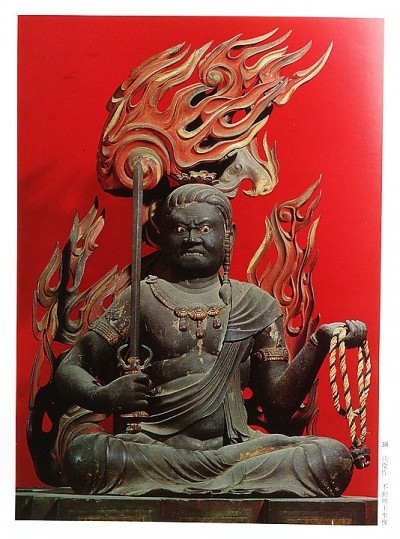
I have noticed recently an increase in a particular kind of cynicism. This is coupled to the belief, I think anyway, that large numbers of people believe ideas fall out of the sky. That ideology is self generating.
The snark factor, the snide tone that seems to utterly permeate discourse today, is the expression of the weakened ego, the need to somehow identify with a manufactured “authenticity” (and more on that in a second). The cynic today is ahistorical: ‘Oh they’ve always done that’. ‘Oh, that went on long before….blah blah’, ‘Oh, that’s how people are’, etc. The stance is: nothing new under the sun. This logic takes one, of course, to the atribution of certain human behaviors as part of human nature. As universal, too.
This cynicism resists belief in specific models, or thinkers, or movements as having importance, for the cynic thinks nothing REALLY has importance. Enter snark stage right. My old friend and mentor Terry Ork once said, ‘it is far easier to find a vocabulary for dislike and snark, then it is to develop a vocabulary for robust enthusiasm’. The Cashiers du Cinema critics understood this. The snark white audience to culture seek out that which can be comfortably ridiculed, but always with the understanding it’s not really important anyway. Least of my problems as someone said to me this week. Which is another symptom of this strange confusion of category that seems to happen — the ever shifting sands of topic identification. This manifests itself politically — on the left — with a macho real politik cynicism. The self branding of ‘the authentic world weary realist’. This is the province of the deeply dissapointed, the realm of lost dreams.
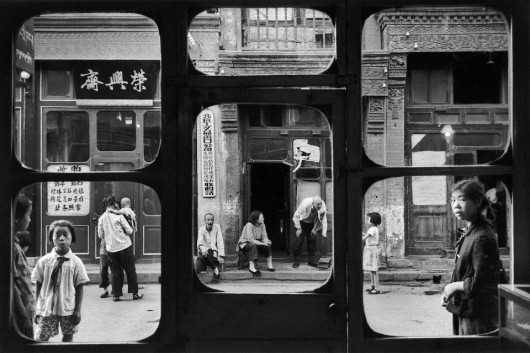
Beijing (Peking), 1965
This is a posture of absolute terror. I think more a condition of men living under advanced capital, actually, than women. For women the authentic remains wed to identifications of power, and the weariness trope takes a different form. The political is treated cynically, and the examination of ideological evolution is stopped short. Why? Because ideas fall from the sky, not the books of Hegel, or Leo Strauss, or Schmitt or Zizek. That ideology is a product of the state, but that somehow the state operates in a vacuum. The cynic says, oh, Zizek is of no importance, nobody listens to him.
Nobody listens to anybody.
Now, the fact is, that statistically, for non fiction books, the average number sold by any author (last year) was under 300. A distorted statistic, I grant you, but still… publishing is in crisis. A figure such as Zizek however, DOES have importance and does effect things. The latent racism and xenophobia that finds expression in countless daily news items is made a trope, a meme, by celebrity thinkers such as Zizek. What is insidious of course is that Zizek is marketed as a Marxist (and Lacanian)…when he is neither.
Of course public intellectuals, whether read or not, influence the behavior, the thinking, and the actions of both individuals and groups.
They shape ideas in ways that effect funding and they appear on panels and at symposiums and colloquies and conferences. The brie and chablis circuit for “guest lecturers” is vast and includes everyone from Don Rumsfeld to Pat Robertson. It includes a good many academics; from the lesser known to the more visible such as Cornell West or, well, Zizek. Now, to what extent, these ideas, these ideological positions, directly effect events? Hard to say. At this point we had better define “directly”, and we need to know what “effect” means. Still, it’s not very hard to track the echos of celebrity thinkers like Zizek on public events. A recent and pretty noxious symposium on “The White Working Class”, (http://www.independent.co.uk/news/uk/politics/poverty-tsar-frank-field-white-working-class-need-own-citizenship-ceremonies-8559004.html) has a distinctly Zizekian flavor to it (and of course this mixes with a Badiou or whoever, an object oriented Nazi…er….Heideggarian…). Now, the difference between Heidegger and Zizek is that Heidegger was a profound thinker, and as such constitutes one of the great 20th century intellectual knots in need of untying. Zizek is not. Zizek is crypto fascist, racist, and misogynist (and not so crypto in his misogyny).
The Cynical posture, the snark I’ve written about before, and the white longing for “authenticity”, relates to the wholesale misogyny of the society at large. It is a posture asking for power where power is known to be embedded in the state and not the individual. It is, again, the weakened ego. It is also, this quest for “authenticity” (which often, is denied, as in “I dont give a shit about the authentic”), a symptom of an age in which emotions have been so manipulated by mass culture, by the sentimentalizing of almost every public tragedy, the over emotionalizing of trivial events, that a reaction formation seems to take place that displaces critical analysis and leaves the increasingly emotionally numb subject in his or her own small cul de sac of identifications and presentations of self. Social media, again, plays a role in this, and encourages it. Like/not like. Twitter, where discourse is limited to fragmentary sentences. And usually under an alias. So the quest for a deeper emotional life seems understandable. I suspect humans feel starved for deeper emotional connections than those felt at the death of a celebrity (who few actually knew or had ever met) and facebook “friends”.
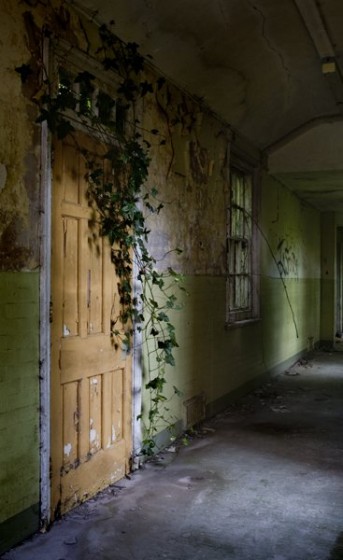
There are social forces, material and historical conditions that compel behavior. However, the ideological backdrop as well as the specific articulation and explanation or justification for behaviors is the result of public discourse. This is what culture is and does. Today, though, the state is managed, as is the military (per Randy Martin), much like a wall street analyst manages hedge funds. A systems analyst. The goal is to manage (risk averse) the *present*, not the future. The future is romantic and idealistic. The past is nostalgic and unimportant.
Aesthetically, this cynicism has as great an effect as sentimentality does — and they’re connected. In a system promoting, compulsively, the *new*, the cynic says, oh *nothing is new*.
I wanted to digress just slightly here; for I was looking at a painting the other day. I cant find it again and it doesn’t really matter. It was of a front seat of a car. The car was parked in the desert, at sunset, twilight. It was rather neo-expressionist I guess, but had an almost hyper-realist patina to it. I glanced at it, and thought, well, nice — struck me as a sort of appealing minor work of what was really illustration. Then I noticed a pair of women’s shoes on the front seat of this car. Suddenly the painting was sentimental. That was the visual cliche that drained all other mimetic readings of the painting. It was suddenly BAD illustration. I bring this up because I see it more and more. The imprint of the cliche. It is often sentimental as well, but it doesn’t have to be. One of the reasons I wrote about the New Topographics a few weeks back was because of the restraint those photographers possessed. If there are no shoes in that painting, one is allowed the process of engaging with the mystery. The painting then asks a question. Where is the driver of the car? That is perhaps the first question, for there would be many. Now…with shoes, there are none. Plus, the suggestion of “barefoot” in the open desert is a doubling of the first cliche. Barefoot is the signifier for kitsch freedom.
Below are two photos. One with a human figure in it, one without. Neither is sentimental. But why is the photo with the figure not sentimental?
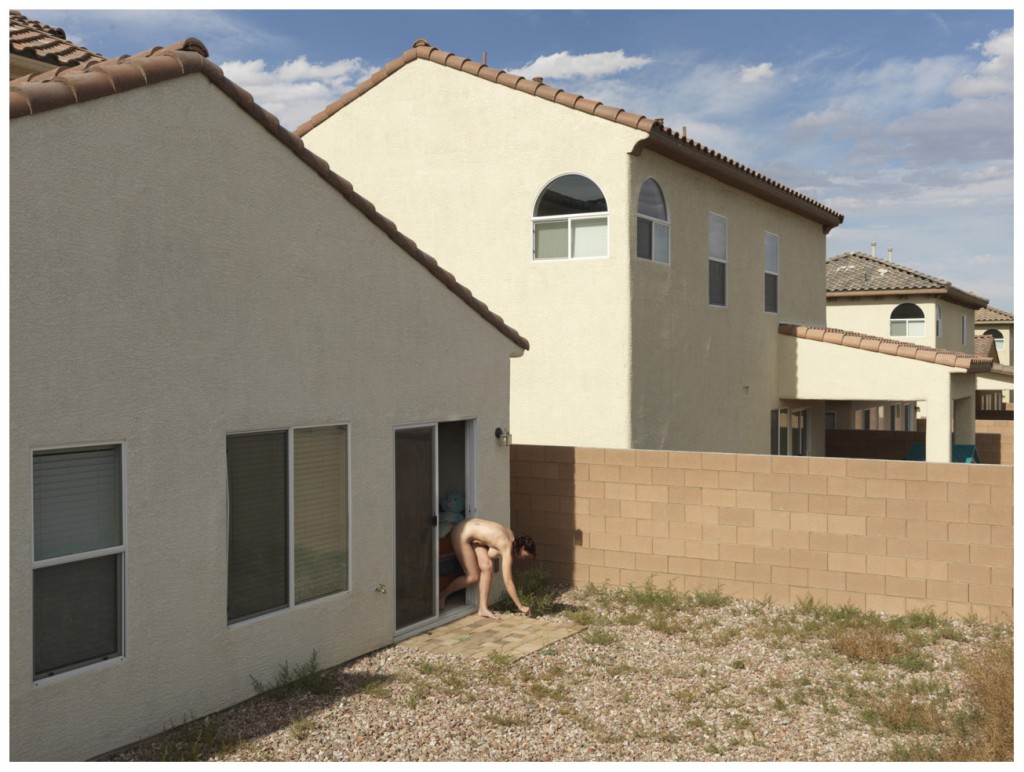
Las Vegas, Alec Soth
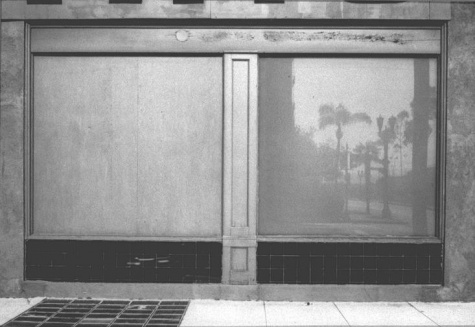
Pasadena, Ca. Lewis Baltz
What I am trying to suggest here is that artworks ask questions. They interrogate the viewer, they ask simultaneous with our asking. We always ask “who”. In the Baltz photo, the who is not in the frame. It is perhaps the photographer. It is perhaps, as Flusser says, that the camera has absorbed the intention of the photographer. That intention here is to displace the ubiquitous quality of “new” — to provide information that is not the same as we get everyday, the ‘same’ which is always ‘new’. As Flusser said, if newspapers showed up, or internet news displayed, the same photographic image everyday for a year, that would be strange. That would cause us to look differently at the image. The fact that everyday we are provided with ‘new’ images is numbing, and we long ago stopped looking at them. As Sartre said, you *cant* see them. The obsessive demand for innovation is really the demand for the same.
But this relates to the sense I have of this resistance to sincerity, to enthusiasm, and to a belief that ideas are not meaningless abstractions. Ideology is a word rarely used in U.S. mainstream media.
“This view of the photographic universe challanges one to look in two directions: towards a society surrounded by the photographic universe and towards the cameras programming the photographic universe. It challenges one to engage, on the one hand, in criticism of the post industrial society that is coming into being, and, on the other, in criticism of cameras and their programs; in other words: to critically transcend post industrial society.”
Vilem Flusser
Behind each technical image one must see the advertising systems, the marketing, the production apparatus, and the distribution monopoly. All of this is increasingly managed and automated, is linked to the risk averse financialized culture of 21st century Capital. The hegemonic system of reproduction of ideologically mediated image cannot be resisted if one remains trapped in postures of paralyzing subordination to this training in cynicism.
The need for criticism, for engagement with aesthetics, means to open those wounds of our battered psyches, and more, to understand that battering is the result of the learned ideas of a system of social domination. The cynic is neutered, is rendered inert and compliant in his or her posture of disengagement.
One of my favorite painters is Kenneth Noland. There remains a lingering residue of masculinist disdain for abstraction. The far reaches of this leads one to Norman Rockwell (or Thomas Kinkaid), while the less vulgar will still look to what Adorno called “the layer of mediocre tacit agreement”. The technically proficient. Language itself (in its interpretive function) cannot free itself from its communicative dimension. For language “has been devestated by commerce and communication, by the ignominy of exchange” (Borchardt).

Kenneth Noland
A painting such as this by Noland requires firstly, a knowledge of his whole body of work, but also for lack of a better word, an educated aesthetic (and in person the sense of scale is hugely important, for often these are very large canvases). Again, Adorno; “The otherness toward which language moves is indistinct and ungraspable, speaking into a darkness”. That darkness is both within and without, it is our forgotten trauma, and that which we desire. The crude mis-readings by Zizek, his veiled authoritarian ideology, are part of the fabric of a totalitarian society. The arguments of the cynic dismiss all this, because it is not the pre-formed branded authentic world of classificatory ordering. It grants too much significance to the “other”. Its as if acknowledging the power of hacks and charalatans, propagandists, is a personal affront. It is too close to the spiritual wounds that are covered and protected by postures of power. For the addiction to the imagery of power is most seductive to those most powerless. Or those who feel so.

In theatre, the Norman Rockwell effect is clear if one looks at Broadway or even mid sizes houses in New York. The elliptical is avoided, for the liberating effect occurs when gaps appear in narrative that force that narrative to vanish, even if only briefly. And nothing liberatory is allowed. As in architecture, that which announces itself as people-friendly is always the opposite. The neatly contained plot is the denial of the human, it is an acceptance of confinement. The cynical stance (of the left) is often to denounce all culture as bourgeois — it is the last traces of vulgar Marxism, of the fantasy of revolutionary insurgency. Culture is derided as elitist, or soft.

Alec Soth
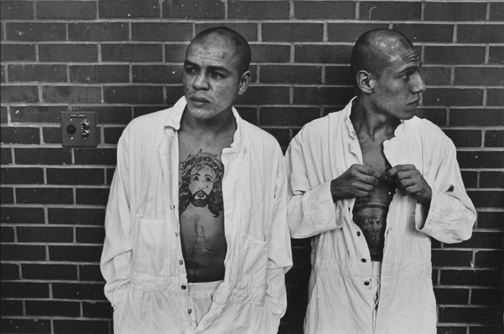
Danny Lyon
The staggering soul wrenching violence of western Imperialism exists as part of a dialectic with the protestant values of denial, puritanical distrust of the Dionysian, and a deep belief in progress in and of itself. Manifest Destiny, the slave trade, genocide of Native Americans; this is forever the backdrop of the U.S. sensibility (and part of the Euro white supremacist project still alive, but on life support). The psychic damage done to the Colonial powers, the internalizing of this violence, the guilt, are all predictive indicators for the ever thickening mental and emotional carapace of the western world’s white population. There seems a weird almost hallucinatory blurring of public and private, now. This is the tightening enclosure of corporate kitsch and propaganda; the constant reproducing of the same under a rubric of innovation and freshness. Sustained growth, culturally, in artists is less and less possible because of the demand for economic returns NOW. The turn around of product occurs in less time than ever before, almost as soon as a product is introduced (whether iPhone or TV Show) the replacement product is on its way. Sustained narrative, expanded story, in TV, interestingly, has carved a niche market in shows such as The Killing, Campion’s feminist noir “Top of the Lake”, and a few others — indicating at least a small corner of the public desires some release from the “new”. Some respite from the cadances and industrial rhythms of relentless repetition. Of course, in world terms, we are discussing the small educated west. But this brings me back to the cynic and this distrust of ideological creation. We are all enclosed within this, if we live at least comparatively privileged lives in the West — and I think that term is worth discussing. My life, for example, in the U.S. was (to use a term popular these days with sociologists) borderline food insecure, no health care, and with a police record, a life of anxiety connected to random police stops and surveillances. This is the new normal. Still, I had the trappings and appearance of a coherent bohemian/artistic existence. Millions more, living thirty minutes from the gated communities of Bel Air or Beverly Hills, or Malibu live in much deeper insecurity. The paradox is, however, that the communities in which emotional life has the most stability, the most authentic existence, are the ones with the least economic stability. I am reminded of how Raymond Chandler always described the homes of the rich; as mausoleums. Bereft of life and vitality.
The cynical connects very directly to a crisis in masculinity, and that is probably an entire other posting.
The development of aesthetic resistance includes an increased sensitivity to mechanisms of social control, to ideological projects of mass media, and this means to the branding of oneself as well. Social media is insidious in this sense. This is the age of the cult of personality. The transformative aesthetic is that which demands an abandonment of the self to what is not the self. It is the return of what has been forgotten.
As Adorno said, ‘cynicism is just another mode of conformity’.
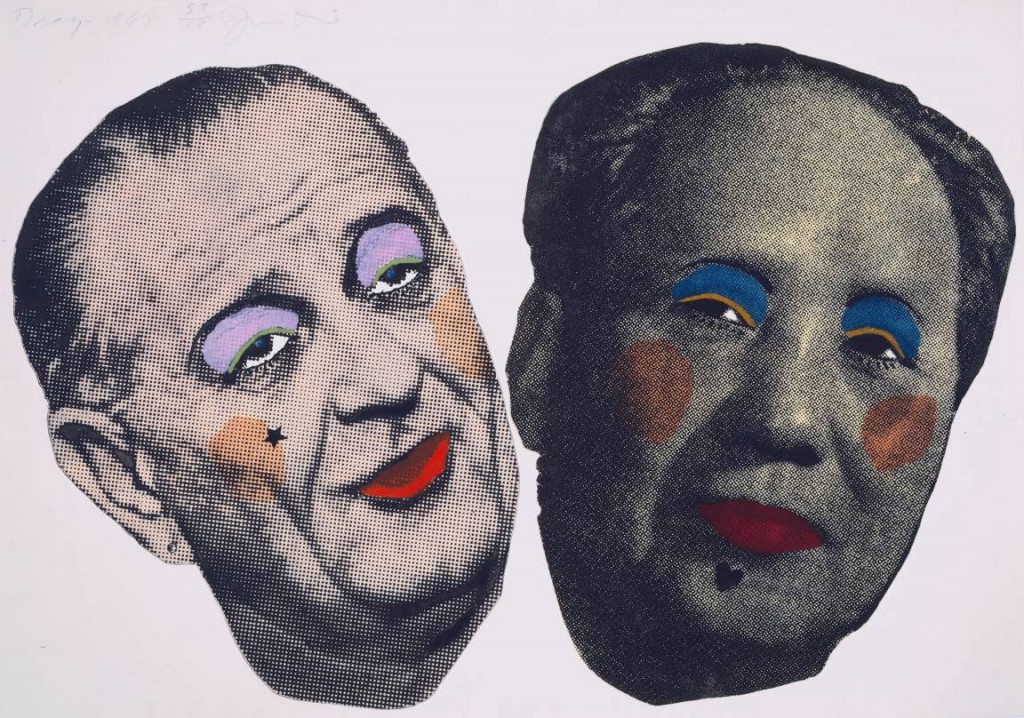

Great stuff, John. I’ve commented before on the astuteness of your take on snarkiness. It’s a disease, or perhaps a symptom of the disease called resignation or maybe more accurately ressentiment. A strange paralysis, a rictus of entrancement, the dreamer fully invested in the illusion of the dream as if it might be possible to live within it…the work of art becomes a total threat…a species of awareness that must be hunted to extinction…It’s tempting to whistle for Nietzsche, who diagnosed the malady of ressentiment so long ago now — that spirit of negation and death-in-life that we lean on in order to achieve the illusion or dream of psychic unity. American culture is fully in the grip of this affect now – the affect of death. It’s becoming impossible to miss.
Made me smile to see Lewis Baltz’s work in these posts. We’ve never spoken about him, but I was blown away years ago by his book on the housing developments outside Las Vegas (I think)…which, of course, is all about ressentiment and snark, the desert of snark.
hey Guy……..yeah, funny I hadnt known of Baltz before, though now I realize I had seen and was drawn to some of his photos earlier without knowing who it was. He is the best of them all — the purest. He captures something very specific………its like he shoots the same thing over and over and over……..like Kafka……thats what he sees and he shoots it. Its very pure and sort of religious.
Well you know I am growling about the fling at we vulgarian Marxists, but it’s a great post, you express this troubling thing so well. I’d like to believe art could intervene but I think the massive complex of mass cocaculture edutainment has effectively deactivated the various capacities art once had in a different context. Now all art in the wired core takes place within this apparatus that absorbs and exploits it for its own reproduction and the passifcation and distraction of the spectators. Where this apparatus is less ubiquitous – say Haiti – the problem you describe here does not exist. That is the hope really – that there are billions on this planet reuyled by force and coercion now but intellectual and psychologically hugh functioning; because of where we are we tend to think of curing our fellows, and worry about how to rescue them – in truth maybe the wiser posture would be tgo write them off for now and hope a nother generation will grow outside this apparatus after those whom it does not produce, but who crucially produce it, take it off line.
I look forward to the crisis of masculinity post, it seems there is an aspect bound to the kind of crisis of adult citizenship that George W S Trow describes in Within The Context of No Context as well as the more encouraging breakdown of (white supremacist) male domination.
That dog in the louis quinze room reminds me of this hilarious scene in Les Tontons Flingueurs; the movie is a charming French mafia comedy where a young woman who was raised by her marifoi uncles has fallen in love with the son of the head of thee IMF who is an avant garde composer, and he has this rant about the crusty bourgeoisie but its seen partly through the eyes of the mafiosi uncles who are trying desperately to perform bourgeoisisme
fling at *us* vulgarian marxists should say!
@molly: oh, im not attacking marxists, only that sort of factory marxism I associate now with hard core trots. Im as much a material marxist as anyone, but I think there is a very unfortunate inability in a lot of trotskyists to address shifting relationships in production and value, etc.
As for what you say regarding art and those outside the enclosure, as it were…….I do tend, largely, to agree. But…..I think we’re probably being simplistic to a degree….there are enclosures within enclosures….and also ways in which that works on certain mediums that allow for some resistance—— but, that still begs the question of a majority audience that is utterly asleep , in a sense. Its stunning to me sometimes, the sneering arrogance of white america, the liberals who paternalistically refuse to engage with the idea of they themselves being caught within this master narrative, this system of hyper branding, etc. I think the first step is to know NONE OF US escape it. We can only slowly incrementally inch our way out of various cages (to push the metaphor). We have to see our own language used against us, and our expression co-opted, etc etc etc etc. If you see it, if you can be aware, you can work at correctives. Both politically, and artistically. Its so complex…..but I see work that addresses this. That said, the most energy in arts comes from south america, south asia, and africa….thats my very clear sense. Without question. The next great movement in film will almost certainly come from Africa or South America.
John
Hope all is well.
This piece is challenging, as it brings forth a multi-dimensional analysis (art, politics, psychosocial and so on). My first reaction was a sense to expel something and then a retraction (Freud). I am here moving in a personal-emotional reaction to this piece as I took the time to read the entirety of it (which is actually unusual for me online.)
1) Zizek’s seems to represent a culmination of various forces, much as Hegel did. If the 19th Century was the Hegelian Century, and the 20th the Heideggerian Century (which I surmise in the so-called West they were) then the 21st Century seems to be, unfortunately, the Zizekian Century. As Hegel represented incomprehensible “jargon” (Adorno) and Heidegger followed in his wake, Zizek represents a mish-mash or mashed potatoes of various 21st Century ‘flat screen’ (ontology?) ‘object oriented’ hipsterism. His biggest fan club seems to be 20 to 30 something quasi hipsters (for there are only ‘quasi-hipsters’)
2) Hipsterism, with all of its class fragments, seems to represent both a resistance to- and an acceptance of- white middle class ‘frictionless’ soft narcosis and necrosis. As the imperial ambitions melt down, the Empire Strikes Back, and this fragmentation between the cyber-smooth and the brute real seems to throw entire populations into stupor and a severe repressive inability for self-reflection (note the manic need of people to check their smart phones in the streets, the wires hanging from their ears pumping tailored made musical realities, the sound bites turning into painfully one-dimensional nothings etc.)
3) Psychosocially we are all growing toward some mad explosion. It is worse than the paranoid repression of the 1950s West; and the 60s may look like a tame decade compared to what we are about to enter. As energy and resources are scarified, unlike the booming economies of the Western nations in the 60s, the choices become more cynical. A ‘raising of consciousness’ and a ‘movement’ may no longer be even words with meaning. I am HIT with a sense of reaching a the nadir of a deepening lacuna, a nadir that continues to lower and increase, the abyss gets deeper, higher and tighter. The air is becoming unbearable; we are allergic to existence itself. The mid-60s allowed for an outlet of this from the proto-fascism of the 50s and the real fascism of the 30s and 40s. We have no such outlet now, except of the ever (eternal) return of narcissism and narcosis. Zizek and Badiou are representatives of the cynical masochism of the masses, what Wilhelm Reich diagnosed in his “Mass Psychology of Fascism”
This post led me to think about the films of Wes Anderson, in my mind one of the two Andersons in America still making good cinema (the other being PT Anderson whose film “The Master” you talked about recently). Whenever I think of snark, posturing, and cynicism, he occurs to my mind as a photo negative of everything snark represents. I find there is a refreshing sincerity and genuine good-naturedness in his films. One thing that a lot of critics seem to misunderstand about him is that they mistake him for the common type of “indie” director who relies on “quirky” prestige effects (the ones we all rightly hate). But after watching his films I came to the conclusion that he is decidedly not that. One sign of that is that every film of his has an absolutely individual and unique idiolect of storytelling that distinguishes it from his other films. In other words, there is no indiscriminate blanket application of prestige effects of quirkiness without regard to subject and story. He does have certain technical devices that he comes back to, but that is something as natural as a person’s gait and not put on, and it serves the structure and meaning of what he’s trying to convey. (It’s like the sophomoric criticism of Shakespeare characters always sounding the same and having no variety of voices because he keeps using iambic pentameter, even though the pentameter of “Romeo and Juliet” and “Coriolanus” have nothing in common with each other other than the meter). And if he makes use of “quirky” indie effects, he’s only appropriating them as part of a bigger structure and not as an ends to itself. Think of Shakespeare incorporating popular saws, or pop tunes and ditties that are shallow on their own but transformed when incorporated uniquely in “Twelfth Night”. (I think all great artists make use of cliches — certainly great art cannot afford to discard something as banal as fashion, although that’s a whole different topic worthy of its own thread — but only cliches as technique, as efficient means, bricks in an architectonic that’s NOT cliche, rather than as a pure end)
He also eschews the arch-realism modus operandi of Hollywood. A friend described him as a “cheerful expressionist” — certainly an apt description. What impressed me in “Moonrise Kingdom” was the use of the natural mise-en-scene as a part of the psychological universe of the characters. There is something Shakespearean about that mirroring of inner and outer reality, not the only form that the uncanny can take but certainly a very potent one. (I know comparing a genius like Shakespeare with an untested-by-time upstart director — one that still has a lot of knots to work out — is hazardous, but there we go.) A New England friend alerted me to the connection between the framing device of the intruding narrator (he plays a minor role) and the New England tradition of tall tales — so his “meta” framing device isn’t just a gimmick, but deeply rooted in tradition (thus history), and a tradition that emphasizes the uncanny at that (the tall tale as the manifestation of subconscious, the American counterpart to Grimm).
And of course he is a cheerful optimist, but I think more in the tradition of Walt Whitman’s optimism rather than the all-too-American New Thought/New Age/New Religion optimism of “pain doesn’t exit / if you think it’s not there, it ain’t there / when you BELIEVE you are a God, you ARE God, thus nothing is wrong if you SEE NO wrong.” Again I go back to “Moonrise Kingdom”, which I think is in a way his first complete, mature work as compared to his experimentation-in-progress of earlier films (“Rushmore” and “Royal Tenenbaums” being prime examples of inspired cinema that unfortunately retains vestiges of the flat-footed device of Hollywood-style montage sequences, robbing it of much dramatic tightness). First thing we notice is that, like Grimm, his fairytale world does not shy from violence, or sexuality, or danger. Secondly is that the violence is frankly depicted, but with none of the exhibitionist “let’s show how it’s done, let’s make them go oooh look at that blood spurting out, isn’t that gross!” Instead it’s the moment before and moment after that’s emphasized. (Again the topic of graphicness as antithetical to the nature of drama can fill a whole essay — see how Grimm shows violence, but never with uber-realistic pretence). And of course, the ending looks Disney, it superficially SEEMS like Disney. I mean, orphan kid is happily adopted, and ooh look the lawyers actually have a heart after all! But it is in fact something else entirely. First of all, the Social Services character is irredeemable. The truth of institutions are never softened to make them benevolent parental figures. And of course the final scene shows that being adopted is not an act of having rebelliousness subjugated — there is no “taming the wild orphan” narrative here, so the whole film maintains a healthy celebration of rebellion, hence individuality. Another thing that makes the ending something else entirely is the feeling of bitter-sweetness. Now that wistful feeling I find is one of the hardest to achieve in comedy. Again Shakespeare shows us one way of doing it in “Twelfth Night”. The supposedly Disney ending of “Moonrise Kingdom”, even though it ends with the two kids still being together and seeing each other, also contains the hint of the passing of childhood. We are told that the tidal bay was destroyed in the storm and is no longer on the map. Then we see the boy painting a picture, from memory, of that bay where the two children had their idyllic freedom. The final shot focusing on that painting and the expression on the girl’s face tells the whole story — and that’s what creates the bittersweet. Of course there’s also how Anderson depicts the children — none of the fake put-on precociousness of typical Hollywood film children. He allows them to speak articulately and maturely in their dialogue, but relating to their hopes and desires AS children — not as adults project them. And they are constantly aware of how transient their experience is bound to be, so there’s none of the artificially induced naive-stupidity one sees so often in Hollywood children. (The Hollywood trope of “precocious child as Holy Fool” being one of my most hated.)
Which takes me back to how Anderson’s optimism is different from the cynical “you can do anything you want if you can just believe in it” optimism — which is the lack of illusion and the awareness of the transience of all things. The corporate mentality is the exact opposite — they want you to imagine everything as permanent, as THING, as MONUMENTAL. And the New Thought/Age/Religion is really a typical development of the illusion of permanence, the illusion of complete never-ceasing control over a small solipsistic circle.
Which brings us all the way back to snark. And of course snark is the flip-side of the bourgeoise reaction to anything remotely approaching “pain” in art: “ugh, how dare you SHOW me the pain.” rather than “how come there is pain in the world.” I think it is Nietzsche who said something about how it’s impossible to affirm unless you negate some things. Which is the opposite of the bourgeoise “everything’s wonderful, how dare you be so gloomy/pessimistic about what is wonderful.” — seemingly optimistic but incredibly cynical. I know some people disliked “Moonrise Kingdom” because the kids in there fought. Or bickered with the parents, even. Why do they have to show kids being violent/disagreeable, and the main characters at that! (If only the thugs and bullies were violent, we could at least discount that as an aberration, as Hollywood does with cardboard villains/bullies in kids movies.) Now there are plenty of legitimate critiques, but that, as a reason to dislike a movie, reveals a lot.
(Complete tangent — is that why many kid movies are almost absent of functional adult characters, no parents at home — so that the kids won’t bicker with the adults and seem disagreeable?)
And one final thing — I think the necessity of accepting cheerfulness and optimism, the qualities of light, which is why I thought I should bring up Wes Anderson and relate him to your topic on snark. Because what you talk about, “ambiguity” or “creating a psychic space”, a lot of seemingly serious-high-brow-oh-so-deep films emulate, but at an incredibly shallow level. The use of “alienation effects as prestige effects”. Mumblecore. Just have a character look brooding and mumble, that gives him depth and personality! Makes him reveal the dark side of society! (Cue Ryan Gosling) And of course we can project anything we like in that inarticulateness.
(AM I THE ONLY PERSON TO NOTICE THAT IN EVERY ARTSY-FARTSY ASPIRING TO BE DEEP MOVIE, ALL CHARACTERS TALK WITH KNITTED EYEBROWS? SERIOUSLY, FURROWED BROWS, THE PURSING LIPS AND MEANINGFUL SIDEWAYS EYEGLANCE+PAUSE BEFORE SPEAKING? IT’S A GIMMICK/MANNERISM DEVOID OF CONTENT BUT AS A PRESTIGE EFFECT PROJECTS “DEEP DEPP DEEP PHILOSOPHICAL” IN GENERAL. STANISLAVSKI IS RIGHT, “IN GENERAL” IS THE WORST ENEMY OF ART.)
So in contradistinction to that kind of emulation of “depth effects/depth gimmicks”, an optimistic, light director is a welcome relief.
Which I guess is why I brought Wes Anderson into my reply. I think he demonstrates one way, not the only way, but certainly a valuable way of getting out of snarkiness and creating a modicum of sincerity.
@eilif:
These are good points…..and its true that Zizek is has taken on this role marcuse did, in a sense, in the 60s, for a segment of the academic young. There are huge differences, though, and its interesting to analyse them. First, the students today are more mediated by mass culture and mass culture is more corporatized and considerably more pervasive. It is also now the death of optimisim, and of idealism. While movements exist….and great work gets done at the community level, I see little evidence of headway made in the great Empire’s hegemonic control. Also, those movements invariably exist outside institutional settings. Those community movements are not irrelevant — but they need to be seen as small autonomous spaces (literal and figurative) trying to create meaning outside the walls. The intensifying of power is so acute, by the state. The vast US gulag casts a very long shadow.
‘
So zizek seems this part psy-op experiment (and even if he’s not, he is) who through an incoherent discourse, manages to (above all else) inject these memes of racism, homophobia, misogyny, and…….actually perhaps most insidiously, apologies for neo liberalism. The sense of white supremicism starting to come apart at the seems…..worn out, dying, with no salvation in site…..this is the backdrop in which this quasi-hipster differs from the student movement of the sixties. Zizek fits in perfectly with his crypto-revisionism, historically, and with this masculinist sweaty hairy sort of Branding….I remember when he came out and said The 200 was his favorite film. Perfect. Kill all the perverted Persians…i mean PERFECT. And there he is, clown show, babbling and quoting himself, and making this carefully stage managed remarks that all have this “outrage effect” built in. “Hitler didnt go far enough”……”violent like gandhi”….etc. But the Roma pogram was the quintessential zizekian stance. Although some of his misogynist comments come close —so against this backdrop of ever more diluted theory —- the ever more rarified private languages of Badiou or Zizek, or object oriented idiots, or the endless stream of bland incomprehensible sociologists……the quasi hipster looks for the personal psycho-social posture to take. Institutional learning has never been more visibly compromised — degrees about as useful as bubble wrap now — and this global sense of inside & outside…gated communities of elite privilege, and the wild boys beyond the gates…..this looms as both metaphor and reality. The police crackdowns in the US are real — the repressive tactics, the criminalizing of dissent…all of that is real, and the increases in poverty, of homelessness….the sense of crisis is far more acute now than forty years ago. There was a sort of almost naive optimism about Marcuse, say-. And an art school sort of belief in “play” by Debord and SI…..but today, we have no frontiers to run off to. The drones run out of targets. The LSD protests have been colonized by big pharma and chemical warehousing is the NORM for school age and pre school kids in the west…especially the US. The logic of social domination has been to colonize consciousness……create this attention economy, (Beller) and financialized capital (marazzi), and I feel what you rightly describe as this middle class soft protest, the hipster white youth, the privileged white people with their white people concerns….who are thrown bones….stage managed issues from the political theatre machine…..(gay marriage, gun control, etc) about which to argue and debate—- while deportations increase, police executions increase, and in europe a far right sort of backlash is validated (by Zizek among others…Badiou , too). …and as ecological destruction ramps up to crisis level, this sort of counter-revolutionary double speak by Zizek (et al) has hugely damaging effects. It doesnt matter how many people actually read him. They “get” him, they watch a vid or two, and that trickle down theory effect is real anyway. And so, young people dont learn aesthetics, they learn zizek talking about hitchcock. They are granted permission for racism, homophobia and find ammunition in their desire to prop up neo liberal , neo imperialist state policies.
Im so glad to read these comments though, because its an important discussion and like Adorno, i really do believe that culture is the last bastion of relief, and also of sprititual renewal somehow.
@exir……….i agree about the Anderson of The Master. Im less sure about wes anderson………thats a big topic, and I appreciate your thoughts here. It may be that wes anderson is reactionary, but in almost un-reactionary way, as was Capra say. In the end, its reactionary —–but there is at least a very useful sort of investigation of conceits…I will write more about this …comment more too………..shortly.
“i agree about the Anderson of The Master. Im less sure about wes anderson………thats a big topic, and I appreciate your thoughts here. It may be that wes anderson is reactionary, but in almost un-reactionary way, as was Capra say. In the end, its reactionary —–but there is at least a very useful sort of investigation of conceits…I will write more about this …comment more too………..shortly.”
Thanks John. I’m still fairly early in my aesthetic development, and I find that my tastes have changed, so that a lot of things that seemed fair before look different now. I think this sort of fine distinction is still something I haven’t yet developed a fully mature “nose” for smelling out yet, and no matter which side of the divide I ultimately fall on, it would be interesting to see ways these distinctions could be analysed.
Looking forward to reading more.
The extreme comical solipsism of OOO was lacerated very amusingly by Christian Thotnd. And it really is similar to Zizek and Badiou’s really hilarious if it were not so pernicious self presentation as perfect conduits of divine mind of whatever…their fury at being reminded of embodiment and concrete limitation harmonizes with the fantasy of Pauline/Savonarola type misogynist ascetic sadomaso reforming zealotry.
Thorne!
John, thank you for your detailed response. I am in total agreement with you, there seems to be no place for this fuse to blow! So where will the coming ejaculation burst forth to- for- from? I am not sure. The US is falling apart as old Daddy Time has his way with the empire, as he did with so many empires before it, and the situation is ramping up in a such a way that the blood is full of pharmaceuticals, toxins and dread. The lacuna is deepening. Lacan noted that as capitalism continues it eats and ‘speeds up’ to the point where it begins to eat itself. Start eating your big toe: that is what the current situation is like on the macro level.